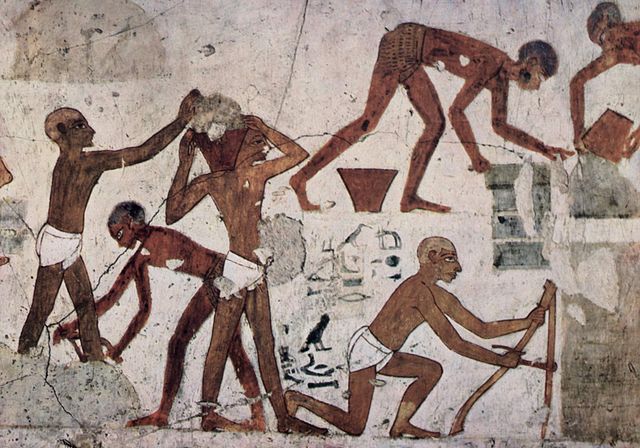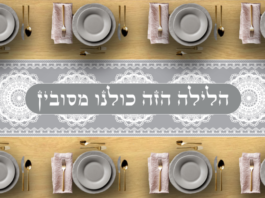EXODUS 1:11
Then the Egyptians imposed [forced labor on the Jews] and taskmasters to [force them to work] and weaken them with hard labor. And the Jews built for Pharaoh the fortified cities of Pithom and Ramses.
TAXES
In the first phase of Pharaoh’s “final solution,” the people of Israel were not technically enslaved by Pharaoh. In fact, in Exodus 1:11–12, the word “slavery” or “captivity” is not mentioned. However, the Hebrew text emphasizes the word “taxes” (missim). Indeed, the Israelites worked for Pharaoh in the construction of Pithom and Ramses. But this form of forced labor was a legitimate legal procedure: it was a form of paying taxes to the government. Pharaoh, as sovereign, had the full right to demand from his subjects any service: joining the army to defend his territories or working on construction projects he deemed necessary. As we saw in Pharaoh’s speech, the Jews were considered foreigners; therefore, they had to contribute with labor instead of serving in the Egyptian army. In this first phase, the labor of the Jews consisted of building the cities of Pithom and Ramses, which, according to the most accepted interpretation, were military fortifications or garrison cities. These fortifications were not built with mud bricks but with hewn stones. We could assume that at this time, the Jews worked in the quarries extracting the rocks, carving them, and transporting the heavy stones for these fortifications. But although these taxes on foreigners were common, the purpose behind this forced labor aimed at the Jews was not lucrative: it was a genocidal plan, as we will analyze below.
GENOCIDE
When Pharaoh delivered his infamous speech (Exodus 1:9–10), warning his people about the seeming threat the Jews posed to Egypt, he proposed a strategic plan to (haba nitchakema lo) and weaken the Jews economically and demographically, forcing them to work in the construction of Pithom and Ramses and thereby making them abandon their jobs and sleep in the fields, far from their wives. In this sophisticated and non-violent way, the power and birth rate of the Jews would be significantly reduced. However, as the Torah explicitly states in the following verse, the Jews somehow managed to make Pharaoh’s plan not yield the expected results.
EXODUS 1:12
But the more [Pharaoh] oppressed them, [the Jews] the more they multiplied and grew. And the Egyptians felt threatened by the children of Israel.
Pharaoh’s plan failed. The people of Israel were not weakened but rather strengthened and continued reproducing and growing. At this point, Pharaoh decides to initiate Phase 2 of his plan: slavery.
EXODUS 1:13
And then the Egyptians enslaved the children of Israel with parekh.
For the first time, our text mentions “slavery,” vaya’abidu, followed by a crucial word: Parekh, which means “total slavery”, that is, the unconditional and indefinite submission of the slave to the master.
To better understand this phase, let us recall the previous phase: “taxes.” The Jews had to fulfill an assigned mission: building Pharaoh’s projects. Surely, they had to pay for the construction materials out of their own pockets, but they were probably allowed to hire workers to carry out these constructions for them. And more importantly, once the construction project was completed, they could return to their lives and routines.
However, in the second stage, parekh, the Israelites were not assigned a specific job, a construction project for Pharaoh. Now, they had to work as servants of the Egyptians! Pharaoh declared them “enemies of the people.” The Jews were captured, chained, and assigned to the Egyptians to work for them 24 hours a day. They were now completely at the mercy of their new Egyptian masters, who had total control over their lives.
PHARAOH’S WILLING EXECUTIONERS
Visualizing this scenario is very difficult from the comfort of our modern and prosperous lives. I could only think more realistically about this type of slavery by recalling the Shoah. The first time I read a comparison between Egyptian slavery and the Holocaust was in Elie Wiesel’s book, Job: Ou Dieu dans la tempête. Following Wiesel’s line of thought, in this second phase, the homes, properties, and goods of the Jews were confiscated by the government and handed over to Pharaoh. The Jewish men, women, and children were forcibly captured, taken from their homes, humiliated, and brought to “ghettos,” similar to European Jews in 1940. But then, instead of being taken to concentration camps, they were handed over to Egyptian civilians to be used as free labor. This little-known idea — that in this stage, the Jews did not work for the government but were handed over by the government to common Egyptians — was mentioned by Rabbi Meir Wisser, the Malbim (Russia, 1809–1879). He explains the word ”Mitzrayim,” mentioned in verse, not as “Egypt”, i.e., the Egyptian government, but as the genitive “Egyptians”: “And the ordinary Egyptians enslaved the children of Israel.” In other words, similar to what Daniel Goldhagen describes in his book Hitler’s Willing Executioners, ordinary Egyptian civilians were complicit in Pharaoh’s regime. The Malbim writes: “The Jews were taken as slaves, but no longer worked for the monarch [the government], but for the general population. The Israelites were now the slaves of the slaves [of Pharaoh] and were obliged to do any work that any Egyptian requested.”
EXODUS 1:14
“And [the Egyptians] embittered the lives [of the children of Israel, forcing them to do] the hardest labor, [like extracting] mud and [making] bricks…”
This verse describes the sadistic and brutal way the Egyptians treated their Jewish slaves. The biblical text mentions here the word vayimareru, “and they embittered their lives.” From this Hebrew word comes the word maror, the bitter herbs we eat on the night of the Pesach Seder to remember the bitterness of Egyptian slavery. But what was the source of this animosity against Jews? A master usually takes good care of his slave. The African slaves brought to America in the 18th and 19th centuries, for example, were traded at a high price. And the masters, although they exploited them in the cotton and tobacco plantations, also took good care of them. If not out of compassion, they did it out of convenience. Caring for slaves was like caring for one’s own assets: masters treated their slaves at least with the same care they treated their animals.
WORK TO DEATH!
However, the Jews in Egypt were treated differently, with “bitterness,”“resentment,” and “hatred.” There was something counterintuitive and personal in this mistreatment. One possible explanation is this: for several decades, from the time of Yosef until the new dynasty that ruled Egypt, the Jews lived a privileged life. They lived in a safe and fertile area, Goshen, where they enjoyed wealth and prosperity. And it’s even possible that many Jews had Egyptian servants working for them. Now, Jews were accused by the Pharaoh of having obtained their wealth by exploiting the ordinary Egyptians (ran veatsum mimenu). Now, Pharaoh gives the Egyptians Jewish slaves —perhaps their former prosperous masters! For the Egyptians, it seems, it was a moment of payback and revenge: the Jews were now absolutely at the mercy of their resentful Egyptian masters, who aimed to embitter their lives and make them suffer, torturing them physically and psychologically.
THE MOST UNSANITARY JOBS
The slavery of the Jews in Egypt was not a classic market slavery. The Jews were not treated with the deference given to assets or animals but as hostile and treacherous foreigners. The Egyptians must have felt that their mission was to take revenge on the Jews and make them suffer while they worked for them. The Jews were portrayed as the enemies of the people and eventually had to be eliminated. How to do that? Our text briefly mentions that the Egyptians assigned the Jews the most hazardous and deadly work, tasks that no one else in Egypt was willing to do. The examples mentioned in the Torah are chomer ulbenim, mud and bricks. Probably one of the most exhausting and dangerous work to be done in Egypt. Mud bricks or adobe were produced by mixing mud with silt, which was extracted from the bottom of the Nile River and dung. Silt clings to the skin and is very hard to remove. That mixture was stirred with hands and feet for 4 or 5 days until it reached the point of fermentation. Then, straw was added to that mixture so the bricks would be stronger, more solid, and more durable. All this work was done in the swamps of the Nile, infested with crocodiles, hippos, mosquitoes, etc., and under the scorching sun that burns the skin.
Maimonides explains that the Sages introduced the Mitsva of Charoset at the Pesach Seder to bring to memory these traumatic, unforgettable images. The brown paste recalls the color and texture of the silt and mud, the vinegar, the bitterness, or the tears we shed in our captivity. And the tebalin, edible herbs or spices cut into thin and long pieces that were part of the original recipe of our Sages’ Charoset — brings to visual memory the straw mixed with the mud. That labor became a trauma we will never forget.
THE EGYPTIAN SHOAH
The ultimate goal of Egyptian slavery, abodat parekh was the same as that of the European Shoah. The life of a Jew in Egypt, as in 1940’s Europe, had no value whatsoever. Not even the value of labor. Jewish slaves in Egypt were like prisoners in concentration camps. They had to work until they died. In the Egyptian working areas, as in the concentration camps of Europe, there were no infirmaries to treat sick or injured Jewish workers. If a Jewish prisoner became ill, he was left to die and quickly replaced by the next prisoner. The Jews in Egypt and in European camps were not treated as valuable labor slaves but as despicable enemies of the people to be exploited before they died from hunger, illness, or exhaustion. Both in Egypt and Germany, Jews were deliberately subjected to the most unsanitary and dangerous jobs, such as extracting mud from the Nile or working in the unsanitary coal mines in Mauthausen. Because for both the Germans and the Egyptians, the ultimate goal was not the product of the Jew’s labor but their extermination.
One last chilling observation: deadly slavery had a special name in Hebrew: abodat parekh. Incredibly, it also had a unique name in German: Vernichtung durch Arbeit, which means “extermination through labor.”
This horrific expression defines specifically the practice of the Nazis in concentration camps against Jewish prisoners who had not been killed in gas chambers to exploit their labor until they died.
Wikipedia: “Extermination through labor” was the practice used in the concentration camps of Nazi Germany to murder prisoners through forced labor.
This shocking phrase — Vernichtung durch Arbeit — did not originate in ancient Egypt, but the reality it describes is tragically present in our earliest national memory. When we sit at the Seder and look at the texture of the Charoset, we are not only remembering slavery, we are bearing witness to a systematic attempt to erase us — and to the miracle of our survival.



